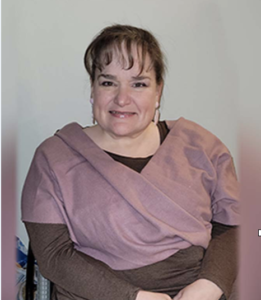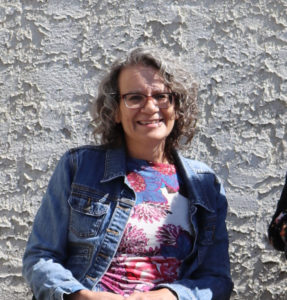How AI Is Improving Hearing for Canadians with Hearing Loss
By Sheila C. Serup, President Calgary Branch of CHHA

For Canadians with hearing loss, artificial intelligence (AI) is significantly improving hearing and connection in many ways.
Already AI is enhancing auto-captioning, expanding the capacity of hearing aids and assistive devices, and may provide future tools for communications such as transitioning sign language to text and to speech.
How AI is Expanding the Processing Capacity of Hearing Devices
Currently 1.5 billion people worldwide live with hearing loss. The World Health Organization predicts that by 2050, this number will increase to 2.5 billion. Ensuring that all people with hearing loss have access to hearing support, tools and resources is beginning to correlate to developments in technology and equipment with AI.
“Hearing aids, like all technological devices, are advancing at a staggering rate,” observes audiologist Dr. Carrie Scarff, lead audiologist at her clinic Audiology Innovations based in Calgary and Red Deer, Alberta.
“Current hearing aids use aspects of artificial intelligence (AI) to improve their processing of the user’s sound environment,” she explains. “They ‘listen’ to your environment and can determine if you’re in a restaurant or a coffee shop, an echoey lecture hall, or walking in your dog park with plenty of dogs barking in the background for example.”
“They use their immense computational power to monitor and then compare information to millions of sound examples. They then process these sounds for you almost instantaneously and provide more selective enhanced sounds to your ears and brain. The goal is to improve your ability to detect important signals, including speech and increasing your understanding in a variety of listening situations including noise.”
Result of medical research drives the development of new hearing aids. Individuals with hearing loss today have a wider range of hearing aids to consider that meets their hearing needs and goals. Here are two examples of hearing aids with AI:
One hearing aid can detect when a wearer falls and can send an alert message to up to three people. The alert message includes the GPS location of the wearer. People with mild hearing loss are three times more likely to have a history of falling than their peers of normal hearing, according to the US National Council on Aging.
Some hearing aids are developed on the premise that we hear with our brains. As such, they are designed to provide the brain with the more relevant sounds it needs to make better sense of sound and includes technology to capture more of nature’s sounds.
“Artificial Intelligence in hearing aids also offers access to technological features that can make our lives easier, such as linking us up seamlessly with Bluetooth devices and to ‘the cloud’,” observes Dr. Scarff.
“This can improve the ease of how we can work with our technological systems in our world at work and home, including for remote communication, safety applications, home entertainment, fitness and health metric tracking to name a few examples. These useful technological features that we have access to in AI-based hearing aids, ultimately gives us a bit of a ‘leg up’ on those without hearing aids, which I believe will continue to help to reduce the stigma of hearing loss,” states Dr. Scarff.
For students in school, there are a range of assistive devices utilizing AI and wireless remote connectivity that provide clear and direct access to the voices of teachers, classmates and friends. These systems help students manage noise, reverberation, and distance in a classroom. These systems can also be used for other applications such as meetings.
Dr. Scarff notes that “advanced technology is truly wonderful, however it is only as good to you as how well you are able to make use of it.”
“This underscores the importance of working with a thorough hearing care clinic which can provide information and education about how to use your hearing aids effectively, as well as how to utilize other supports for your hearing such as communication strategies and listening tips.”
How AI is enhancing Speech-to-Text
Video-conference platforms such as Zoom, Google Meets, Microsoft Teams, etc. had limited auto-captioning or automated speech recognition. The speech-to-text functionality has improved significantly, due to AI tools which recognize words in audio sounds and transcribe these into words, phrases, and sentences.
To provide an idea of the ways AI is being used to enhance captions and subtitles, there is a growing toolbox of AI caption generators or tools for video content. If you are producing your own videos, AI can assist in converting the speech to captions. To help convert subtitles from English into other languages, Netflix, for example, has developed what they call a proof-of-concept AI model which can automatically simplify and translate subtitles into other languages.
Sign Language to Text and Speech and other Future Developments
A new Google start-up called Sign-Speak is currently under development in the US to convert sign language to text and then to speech. This project aims to provide businesses with an automated solution to provide services to employees and customers who are deaf.
In conclusion, AI-powered tools and processes can serve as a ‘co-pilot’ to assist individuals with hearing loss to realize their aspirations. It provides intuitive and inclusive communication experiences and is empowering for many people in diverse ways.
The writer invites conversation, ideas and comments on how AI-powered tools and processes have helped your hearing. Email sserup@chha.ca
Sheila Serup of Calgary, Alberta is a CHHA-Calgary volunteer whose second book, Found Fragments: Stories of Courage and Valour, is now at Audrey’s Books in Edmonton.
 Become a Member
Become a Member login
login































